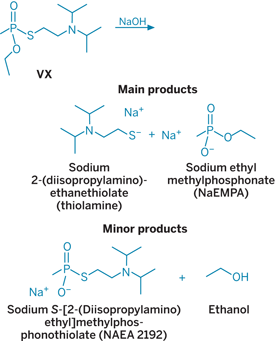Advertisement
Grab your lab coat. Let's get started
Welcome!
Welcome!
Create an account below to get 6 C&EN articles per month, receive newsletters and more - all free.
It seems this is your first time logging in online. Please enter the following information to continue.
As an ACS member you automatically get access to this site. All we need is few more details to create your reading experience.
Not you? Sign in with a different account.
Not you? Sign in with a different account.
ERROR 1
ERROR 1
ERROR 2
ERROR 2
ERROR 2
ERROR 2
ERROR 2
Password and Confirm password must match.
If you have an ACS member number, please enter it here so we can link this account to your membership. (optional)
ERROR 2
ACS values your privacy. By submitting your information, you are gaining access to C&EN and subscribing to our weekly newsletter. We use the information you provide to make your reading experience better, and we will never sell your data to third party members.
Environment
Army Resumes Disposal of VX Nerve Gas
by Lois Ember
September 26, 2005
| A version of this story appeared in
Volume 83, Issue 39
CHEMICAL WEAPONS
VX nerve gas destruction at the Army's Newport Chemical Agent Disposal Facility, in Indiana, resumed on Sept. 14. Neutralization of the nerve gas was halted in June in part because tests found the caustic wastewater, dubbed hydrolysate, to be flammable. Diisopropylamine (DIPA) was fingered as the culprit.
Army engineers, Project Manager Jeffrey Brubaker says, found the recipe for reducing flammability. According to Brubaker, the solution is to mix VX with hot water and sodium hydroxide at 194 °F for one hour. Then the temperature in the reactor is lowered to 150 °F for the remainder of the neutralization process. While neutralization is occurring, nitrogen is passed through the reactor to reduce the level of DIPA in the hydrolysate.
Jeffrey Lindblad, spokesman for the Army's Chemical Materials Agency, says the caustic wastewater produced is being stored on-site in "four intermodal containers" until the Army receives the Centers for Disease Control & Prevention's (CDC) approval to ship it off-site for additional treatment. Until the flammability problem surfaced, a DuPont facility in New Jersey was to receive the hydrolysate for secondary treatment and ultimate discharge into the Delaware River.
There is opposition in New Jersey and Delaware to off-site treatment, and DuPont's operating permit does not yet allow for receipt of hydrolysate. Approval depends to a great degree on CDC's recommendation that transporting and treating the hydrolysate off-site is safe for the environment and the health of workers. CDC spokeswoman Rachel Powell says, "We don't yet have a date for when the final VX report will be released," but it is not likely for several months. At press time, about 4,250 gal of VX had been neutralized and stored at Newport.




Join the conversation
Contact the reporter
Submit a Letter to the Editor for publication
Engage with us on Twitter